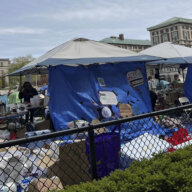By ANNE D’INNOCENZIO Associated Press
Bed Bath & Beyond has filed for bankruptcy protection, following years of dismal sales and losses and numerous failed turnaround plans.
The beleaguered home goods chain made the filing Sunday in U.S. District Court in New Jersey and said it will start an orderly wind down of its operations, while seeking a buyer for all or some of its businesses. In the bankruptcy filing, the retailer said it anticipates closing all of its stores by June 30.
For now, the company’s 360 Bed Bath & Beyond stores and its 120 Buy Buy Baby sites as well as its websites will remain open to serve customers.
It listed estimated assets and liabilities in the range of $1 billion to $10 billion. The move comes after the company failed to secure funds to stay afloat.
In a statement, the company, based in Union, New Jersey, said it voluntarily made the filing “to implement an orderly wind down of its businesses while conducting a limited marketing process to solicit interest in one or more sales of some or all of its assets.”
The store closings will put thousands of jobs at risk. The company employed 14,000 workers, according to the court filing. That’s drastically down from the 32,000 as of February 2022.
Bed Bath & Beyond said it secured a commitment of roughly $240 million in financing from Sixth Street Specialty Lending, Inc. to allow it to keep operating during the bankruptcy process.
“It’s the death of an icon. A lot of people have grown up with it, ” said Neil Saunders, managing director of GlobalData Retail. “It’s an institution in retailing, but unfortunately being an institution doesn’t protect you from financial woes.”
Founded in 1971, Bed Bath & Beyond had for years enjoyed its status as a big box retailer that offered a vast selection of sheets, towels and gadgets unmatched by department store rivals. It was among the first to introduce shoppers to many of today’s household items like the air fryer or single-serve coffee maker, and its 15% to 20% coupons were ubiquitous.
But for the last decade or so, Bed Bath & Beyond struggled with weak sales, largely because of its messy assortments and lagging online strategy that made it hard to compete with the likes of Target and Walmart, both of which have spruced up their home departments with higher quality sheets and beddings. Meanwhile, online players like Wayfair have lured customers with affordable and trendy furniture and home décor.
In late 2019, Bed Bath & Beyond tapped Target executive Mark Tritton to take the helm and turn around sales. Tritton quickly reduced coupons and started to introduce store label brands at the expense of national labels, a strategy that proved disastrous for the retailer.
And the pandemic, which happened shortly after his arrival, forced the retailer to temporarily close its stores. It was never able to use the health crisis to pivot to a successful online strategy as others had, analysts said. And while many retailers were grappling with supply chain issues a year ago, Bed Bath was among the most vulnerable, missing many of its 200 best-selling items including kitchen appliances and personal electronics, during the holiday 2021 season.
The retailer ousted Tritton in June 2022 after two back-to-back quarters of disastrous sales. In recent months, the company, under the stewardship of recently appointed president and CEO Sue Grove, went back to its original strategy of focusing on national brands, instead of pushing its own store labels. But the company has had a hard time having suppliers commit to delivering merchandise because of the retailer’s financial woes.
The bankruptcy filing comes as the company’s shares have tumbled even more as speculation of an impending bankruptcy filing increased. Its financial performance has also deteriorated. In late March, it noted that preliminary results showed anywhere from a 40% to 50% decline in sales at stores opened at least a year for the quarter ended Feb. 25.
Bed Bath & Beyond joins a growing list of retailers that have filed for bankruptcy so far this year including party supplies chain Party City and David’s Bridal. The bankruptcy could offer a window of what’s to come in the retail industry, given the changing landscape and the increasing challenges in the U.S. economy.
AP Writer Bruce Shipkowski in Toms River, New Jersey contributed to this report.
































